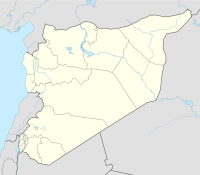Tell Sukas (original) (raw)
From Wikipedia, the free encyclopedia
Tell Sukas
 |
|
|---|---|
| Alternative name | Shuksi, Suksi |
| Location | near Jableh, Syria |
| Region | Canaan |
| Coordinates | 35°18′23″N 35°55′20″E / 35.306318°N 35.922203°E / 35.306318; 35.922203 |
| Type | Tell |
| Part of | Town |
| Area | 1.9 hectares (200,000 sq ft) |
| History | |
| Material | Clay, Limestone |
| Abandoned | c. 69 BC |
| Periods | Late Bronze Age, Iron Age |
| Site notes | |
| Excavation dates | 1958–1963 |
| Archaeologists | P.J. Riis |
| Condition | Ruins |
| Management | Directorate-General of Antiquities and Museums |
| Public access | Yes |
Tell Sukas (also "Teil Sukäs") (possibly ancient Shuksi or Suksi) is a Late Bronze Age archaeological mound on the Eastern Mediterranean coast about 6 kilometres (3.7 mi) south of Jableh, Syria.
The settlement at Tell Sukas was located at the center of the fertile plain of Jableh on a hill with access to two natural harbors.[1] There is evidence of an earlier Neolithic settlement at the site dating back to the seventh or sixth millennium BC.[2] The site was identified as ancient Suksi, which was mentioned in the Ugarit tablets.[3] The Bronze Age settlement was probably destroyed during the Bronze Age collapse.[4] The site was reused shortly thereafter and commercial activity at the Iron Age settlement can be traced again to at least the tenth century BC,[1] when it became the port of Luhuti,[5] A Phoenician settlement was established in the eighth century BC,[6] and the town thrived as a Greek trading outpost between c. 850 BC and c. 550 BC, when it was destroyed by the Babylonians.[3][7] Recent excavations reveal that the site was inhabited again by the Phoenicians between 380 and 69 BC until it was destroyed again, possibly by an earthquake. It was later re-occupied for a short period by the Crusaders.[2]
The site was excavated in 1958–1963 by the Danish Carlsberg Expedition to Phoenicia under P.J. Riis. Excavations uncovered an early Iron Age cemetery south of the tell which was dated to between the 13th and 10th century BC. Excavations also uncovered a large seventh-century Phoenician temple. The abundance of Greek pottery and the discovery of Greek burial grounds suggest that the city became a permanent Hellenic outpost by 600 BC.[1]
- ^ a b c Aubet, 2001, p. 63
- ^ a b Fischer-Hansen, 1991, p. 44
- ^ a b Bromiley, 1995, p. 272
- ^ Drews, 1995, p. 14
- ^ Claudia E. Suter, Christoph Uehlinger (2005). Crafts and Images in Contact: Studies on Eastern Mediterranean Art of the First Millennium BCE. p. 133. ISBN 9783525530047.
- ^ Horden; Purcell, 2000, p. 404
- ^ Tuplin, 1996, p. 36
- Aubet, Maria Eugenia (2001). The Phoenicians and the West: Politics, Colonies and Trade. Cambridge University Press. ISBN 9780521795432.
- Fischer-Hansen, Tobias (1991). Recent Danish Research in Classical Archaeology: Tradition and Renewal. Museum Tusculanum Press. ISBN 9788772891217.
- Bromiley, Geoffrey W. (1995). The International Standard Bible Encyclopedia, Volume 4. Wm. B. Eerdmans Publishing. ISBN 9780802837844.
- Drews, Robert (1995). The End of the Bronze Age: Changes in Warfare and the Catastrophe ca. 1200 B.C. Princeton University Press. ISBN 9780691025919.
- Horden, Peregrine; Purcell, Nicholas (2000). The Corrupting Sea: A Study of Mediterranean History. Wiley. ISBN 9780631218906.
- Tuplin, Christopher (1996). Achaemenid Studies. Franz Steiner Verlag. ISBN 9783515069014.